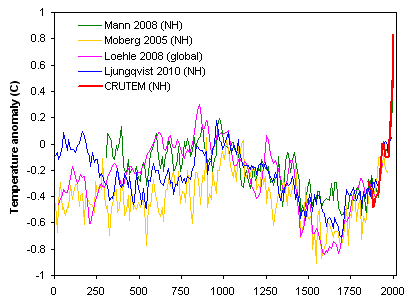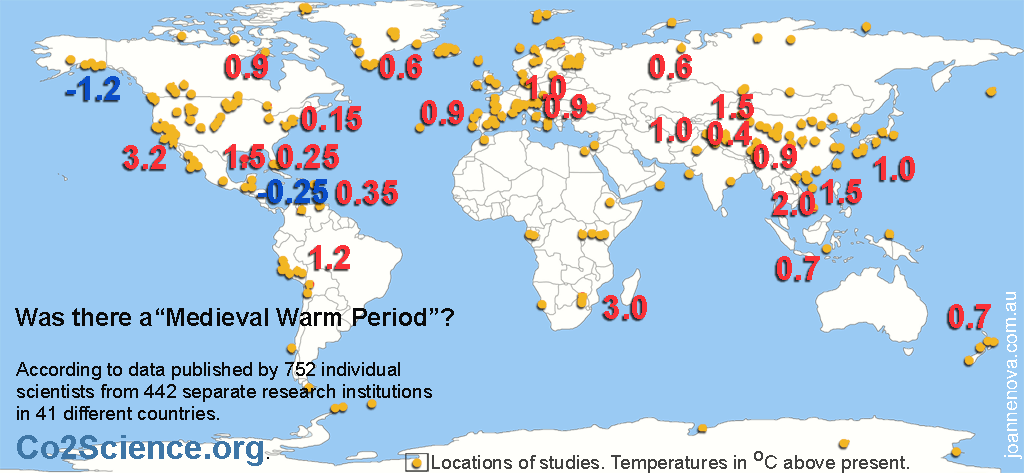Kellerhals et al,
redline shows the little ice age bottom near -.6 to -.8c, which is near -1.2 to -1.4c cooler then the noaa, giss.
I have a hard time believing, because there is no way the mid evil was this cool as cool as the 1900-1910 period, but in a way it does make sense if you think about the impacts of solar tsi on the climate being the main driver. See 1880-1950 was the period of rising tsi in which case the mid evil and this warm period could of been a lot a like when you consider tsi and sun spots.
here is the authors web page with more information.
A 1600-Year Temperature History of Tropical South America
The sun would of needed to put out more energy within the mid evil to make the entire earth warmer then today...Lets not even discuse the past 50 years. That is a very nasty thing.
If the 1950's where the highest tsi in 2,000 years then the med evil wasn't higher.
This proves it wasn't higher!
This shows we're at the highest point in 2,500 years....This clearly shows the Holocene climate maximum from 2.5-8 thousand years ago.
The fact remains that the Medieval Warming Period saw extensive wine production where it can't exist today. Additionally the whole European region saw a massive increase in population during the MWP.
"People keep records of their most important crops, grapes for wine-making being no exception. Ladurie (1971) notes that there were many "bad years" for wine during the LIA in France and surrounding countries due to very late harvests and very wet summers. The cultivation of grapes was extensive throughout the southern portion of England from about 1100-1300.
This area is about 300 miles farther north than the areas in France and Germany that grow grapes today. Grapes were also grown in northern France and Germany at that time, areas which even today do not sustain commercial vineyards. At the time of the compilation of the Domesday Survey in the late eleventh century, vineyards were recorded in 46 places in southern England, from East Anglia through to modern-day Somerset. By the time King Henry VIIIth ascended the throne there were 139 sizeable vineyards in England and Wales - 11 of them owned by the Crown, 67 by noble families and 52 by the church (English-wine.com). In fact, Lamb (1995) suggests that during that period the amount of wine produced in England was substantial enough to provide significant economic competition with the producers in France. With the coming cooler climate in the 1400's, temperatures became too cold for grape production and the vineyards in southern England gradually declined.
"German wine production also declined during the cooling experienced after the MWP and during the LIA. Between 1400 and 1700 German wine production was never above 53% of the production before 1300 and at times was as low as 20% of that production (Lamb, 1995.)"
In Germany, vineyards not only supported varieties of grape that are unthinkable in today?s"
warming climate but areas still impossible for any type of viticulture were supporting vast
wine production. Grapes for wine require not only a frost-free spring but a warm autumn for
added sugar levels required for alcohol production and predictable late frosts that allow
successful harvesting. Production reached tremendous levels with the incumbent economic
impact on ecclesiastical growers to incentify monastic viticulturists to further their pursuits
into the agriculture sciences. With the onset of climatic change, their melding of economic
endeavor with scientific pursuit would allow the survival of Germany’s wine industry while
Britain’s would virtually disappear."
The link is interesting as it has some good scholarly research that shows it was significantly warmer during the MWP then it is today. The Professor must make the typical sacrafice of integrity to the climate mafia in the first paragraph, but his information is good.
The Little Ice Age in Europe - Influence of Dramatic Climate Shifts on European Civilizations: The Rise and Fall of the Vikings and the Little Ice Age
GORDON DUFF: HISTORY OF GERMAN WINES | Veterans Today




